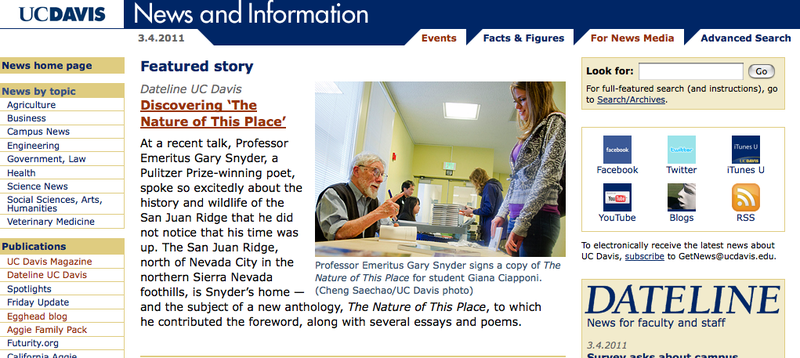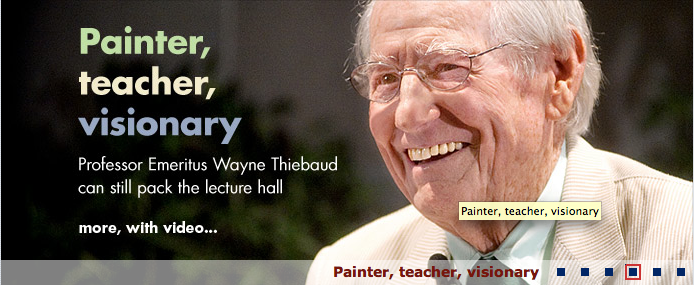Originally appeared in Dateline UC Davis on February 25, 2011
At a Feb. 11 talk, Professor Emeritus Gary Snyder, a Pulitzer Prize-winning poet, spoke so excitedly about the history and wildlife of the San Juan Ridge, that he did not notice that his time was up.
The San Juan Ridge, north of Nevada City in the northern Sierra Nevada foothills, is Snyder’s home — and the subject of a new anthology, The Nature of This Place, to which he contributed the foreword, along with several essays and poems. The talk featured selected readings from the anthology by Snyder and nature journalist David Lukas.
His noontime talk had filled the Memorial Union’s King Lounge, with many students in the audience — students who saw the clock hit 1 and had to decide between going to class or staying to listen to the retired English professor. “Oh, they don’t have to go to classes,” said Snyder, smirking. The audience cheered in response.
He continued on — but not before disclaiming that a discussion of the natural world in its entirety is, simply, impossible.
Snyder recalled something he heard on the radio earlier in the day: “All of the gigabytes of information embedded in computer chips and in media, is nothing compared to all the information out in nature right now.”
Snyder, whose Pulitzer came in 1975 for the book Turtle Island, said environmental issues had been a key concern of his for nearly all his life. On the San Juan Ridge, in Nevada County, he found himself surrounded by like-minded people.
In 1990, this small but spirited community organized a conservation movement, founding the Yuba Watershed Institute, a nonprofit organization dedicated to cooperatively managing 2,000 acres of forestland in and around the area between the middle and south forks of the Yuba River.
‘A unique place, a unique community’
The Nature of This Place: Investigations and Adventures in the Yuba Watershed celebrates the institute’s 20 years of forest stewardship, with a selection of essays, poems, photographs, drawings and observations from the archives of the institute’s annual newsletter, Tree Rings.
In an introduction before Snyder’s talk, co-editor Liese Greensfelder, a former UC Davis news writer who lives on the San Juan Ridge, said: “Readers will find extraordinary thinking and writing about a unique place and a unique community, which, one will not help but notice, is graced with great writers and thinkers.”
In the 1970s and ’80s, the Yuba watershed attracted people from all walks of life: artists, writers, poets, naturalists, biologists, philosophers, historians and farmers. The Nature of This Place reflects this multitude of perspectives, featuring pieces that range from the philosophic to the scientific.
“It would be incorrect to say that everybody who came here, came because of Gary Snyder,” Greensfelder said in an interview after the talk.
And then she added: “But it would be partially correct.”
With help from experts at UC Davis
A number of UC Davis faculty joined the migration to the San Juan Ridge, people like Peter Moyle, Don Erman and Nancy Erman, professors of wildlife, fish and conservation biology, along with David Robertson, professor emeritus of English, and Jack Hicks, senior lecturer in English.
“Genuine experts became a part of the work we were doing, and some of those people were genuine experts from UC Davis. I was always surprised to see how much they enjoyed coming up there,” Snyder said.
“It wasn’t like going to a nice academic conference, or giving a lecture to an appreciative circle of peers. Sometimes it was by kerosene light, and a little chilly.”
Bob Erickson, president of the Yuba Watershed Institute and one of its founders, said he expects more collaboration with UC Davis in the future.
He gave an example: With a U.S. Forest Service grant, Fraser Shilling, co-director of the UC Davis Road Ecology Center, will help the institute create a visual portrait of the area’s wildlife — using remote cameras — to see how the animals use the habitat.
‘Nature is everywhere’
Before the talk wrapped up for good, Brennan Bird, a senior who is majoring in nature and culture, posed this question: “For all of us here who don’t have the pleasure of living in the San Juan Ridge, how do we find connections with the nature of this place?” — meaning the place where we happen to be at the moment.
“Well,” Snyder said, “where are you from?”
“Palo Alto,” Bird replied.
Snyder then probed Bird to name a creek in Palo Alto, and, after that, all the different kinds of trees in the region — until the student could name no more.
“Start with that. I want to reinforce the point that we’re always close to nature,” Snyder said.
He continued, “When I was here in Davis, I was always in touch with the Putah Creek Council. Just walking along the creek, I saw beaver, otter and a lot of other wildlife.
“Wherever you are, take stock of what is happening around you. Nature is never very far.”
On the Web


